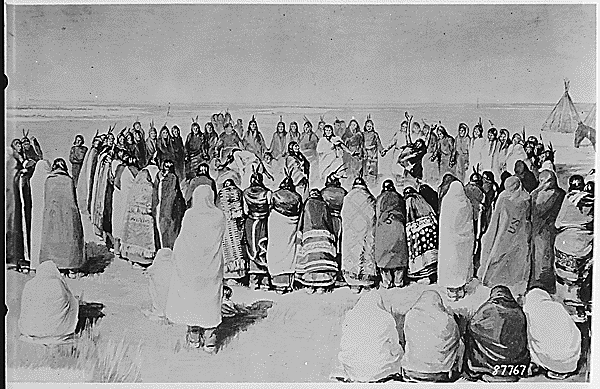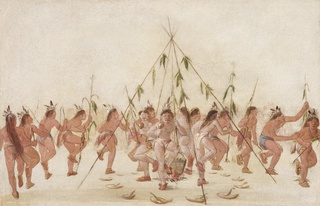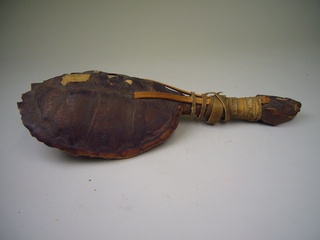Ritual Correlations in Subaltern Dance
By Cervanté Pope•September 2022•10 Minute Read

Unknown, Arapaho Ghost Dance, 1900. National Archives and Record Administration (College Park), unrestricted. Records of the Office of the Chief Signal Officer, 1860–1985, Record Group 111.
Ceremonial dance is a central part of spiritual life for many cultures. The similarities between dances practiced by non-white groups in the United States illuminate shared roots and common goals.
Introduction
For centuries, dance has played an outsized role in the spiritual expression of many cultures, particularly those of non-white descent. The ceremonial practice of dance is an act of physical devotion as well as one of cultural education. Across the rituals of different faiths, there are similarities between dances. In particular, there are correlations between the ways Hoodoo, Voodoo (including both Haitian Vodou and Louisiana Voodoo), and certain Native American and Indigenous Shamanistic practices make use of choreographed movement during rituals and celebrations. Many of these syncretic connections have to do with the dissemination and continuity of sacred traditions through forced migration and colonization—particularly that of enslaved Africans.
The specific moves and rituals vary, but these cultures recognize the basic potency of syncing movement and song, often backed by the power of specific instruments and plant-based tonics or remedies. Individual moves act like the individual steps of a spell, each part of the ceremony building to reach a powerful purpose.
Dance in Voodoo
In traditional African religions and their offshoots in the United States, dance is a reliable anchor of memory. There are two main types of dance in Haitian culture: secular and sacred. The latter has strong and necessary roots in Vodou. During these ceremonies, practitioners connect with spirits known as Lwa through mathematical, rhythmic intervals of drumming accompanied by chanting and rattling.1 Drumming guides these praises, often signaling which song and dance shall be performed for which specific Lwa. Regardless of the recipient, the chanting and drumming build in intensity as the ritual progresses, as does the dancing.
E. W. Kemble, The Bamboula, 1886. The New York Public Library, public domain. Drummers provide a rhythm for the Bamboula.
The Big Drum Dance
While not necessarily intended for connecting with Lwa, one such drum-heavy spiritual dance is that of the Big Drum dance, also known as the Nation Dance, of Carriacou in the Grenadines. Centered around the cot or cutter drum, which leads the dance with the most complex rhythms, two bula drums that handle the more simplistic beats, and a series of maracas and shakers, this dance is considered to be one of the more sacred for the residents of Carriacou.2 While the Big Drum dance is performed more often for entertainment than religious purposes, the Carriacou people still use it to appease their ancestors during joyous occasions like weddings or the start of a new business and incorporate it into funeral rites for the recently deceased.3
Dance Between Life and Death
Carriacou people believe that the dead help bring good health and success to the living, in addition to helping maintain the order of society. The dancers don’t become possessed but enter a trancelike state, said to be joined by their ancestors during that trance. Similarly, practitioners of Louisiana Voodoo use ritualistic dance and music as means of invocation as well as a celebration of life and death. Practices in this region rely on drumming just as heavily to drive specific ceremonies, although accompanied by gourds and banjo-like string instruments.4
As with the Nation dance, the Benin “living ghosts” dance or the Egungun dance is meant to connect the living with the dead. A secret society of tribal members perform the dance, each ornately donned from head to toe in vibrant fashions made of colorful cloth, animal skins, embroidery, shells, beads, and masks that entirely obscure their bodies. The fancier and more elaborate the adornments, the more prestigious and grand the ancestor they’re channeling.5
Dance Under Slavery
Hoodoo reflects the many traditions of the African Diaspora uprooted through the transatlantic slave trade, and shares aspects of West and Central African cultures. Because they had no autonomy in the United States, Africans forced into slavery were also forced to rely on each other, even though most were illiterate and lacked life skills to get through their day-to-day. They spoke scattered native languages and could not necessarily relate to one another verbally. Even so, enslavers attempted to keep communication and cultural education between Africans at a minimum, preventing the many aspects of their heritage from becoming widely known. Yet West and Central Africans like the Yoruba, Kongo Ewe, and more still managed to spread the wisdom of their customary practices with other uprooted Africans, laying the foundations of the Hoodoo we know today.
The Ring Shout Dance
One of those customs is the Ring Shout dance, originally practiced in the West Indies and brought over to the United States through the slave trade. In its traditional form, the Ring Shout involves coordinated clapping and feet shuffling in a counterclockwise direction. The shape participants take is based on the Kongo cosmogram, a symbol comprising a cross with a circle on each end, representing the Kongo people, their faith, and their connection to the universe.6
During African suppression, white Americans tried to Christianize the dance when forcing slaves to convert, transposing the sentiments of the original Hoodoo prayers onto aspects of the Christian God and liturgy. Even in a Christianized society, the Ring Shout continued, eventually inspiring the Cakewalk.
The Cakewalk
While not necessarily a ritual dance, the Cakewalk, also known as a Chalkline Walk, was a form of celebration. Eventually, it was commodified as part of minstrelsy. The specifics of its roots have seemingly been buried by history, though oral accounts say it originated as a plantation dance based both on the prize walk competitions that accompanied emancipation and the war dances of Floridian Seminole tribes. The procession-style dance was steeped in joviality and hilarity. Dancers were thought to be secretly poking fun at the slavers who held them captive and sometimes judged the Cakewalk shows.7
D. Van Wagenen, Cake Walkers Way Down South in Dixie, 1898. Archives Center, National Museum of American History, Smithsonian Institution, Hoffman/Boaz Postcard Collection, public domain.
Bamboula
Named for the goatskin drum it features, Bamboula is a ritual dance and specific rhythm originating in the Congo region of Africa. It was most widely known in Haiti and the rest of the West Indies, as well as nearby parts of the continent, due to slavery. It had a particular presence in New Orleans as a result, and was often danced in the famous Congo Square, typically on Sunday afternoons.
Bamboula hits at a 3+3+2 rhythm, also known as the New Orleans beat, which couples danced to in a circle. But during western colonial development, white slaveholders and plantation owners felt afraid of the dance—much like the Ring Shout—convinced that the practice would only empower the enslaved and lead to a revolt. That fear led to the banishment of the Bamboula in some places, particularly on the Caribbean island of Saint Thomas, where slaves faced public lashings and imprisonment if caught dancing it. In modern times, Bamboula rhythm and dance are still used in rituals and festivals meant to honor the slaves that once lived there.
Dance Across Indigenous Cultures
African-rooted religious practices aren’t the only ones that use song and dance in invocation, praise, and appreciation. Native American tribes across the United States use specific dances in recognition and celebration of what seasons bring, spiritual acknowledgments, and to ask for assistance against hardship, among other occasions. The Green Corn Dance, for example, a type of stomp dance, is part of the annual Green Corn Ceremony celebrated by tribes including the Iroquois, Choctaw, Muscogee, Seminole, Cherokee, and Chickasaw.
The dance, which has several names specific to the tribe performing it, takes place during mid-summer to signal the ripening of corn crops as well as revitalization, new beginnings, and the preservation of health and medicine.8 The ceremony itself can last anywhere from four to eight days, with the festivities of each day representing a different, pivotal phase of the ritual.9 Fasting, chanting, and extended periods of movement are among these phases, which also tend to be split based on gender. Typically, the women dance first in what is known as the Ribbon Dance, meant to purify the ceremonial ground in preparation for the rest of the rituals. Women adorn their legs with shells and rattles while grasping sticks tied with ribbons as a means of cleansing. The men’s Feather or “Fancy” Dance happens next, where they adorn themselves with vibrant plumage. These dance sequences, again like the Ring Shout, move in a counterclockwise circle, after which the fasting portion of the ceremony is broken. Two more stomp dances occur after this phase.
The Ghost Dance
Kwakiutl, Ghost Dance Neck Ring, 19th century. National Museum of Natural History, Smithsonian Institution, noncommercial use permitted.
Unknown, Arapaho Ghost Dance, 1900. National Archives and Record Administration (College Park), unrestricted. Records of the Office of the Chief Signal Officer, 1860–1985, Record Group 111.
The Ghost Dance of the Caddo, Lakota, and many other tribes was also one of hope, health, and healing, but to a more severe degree than the Green Corn Ceremony. It was reserved for times of extreme strife, meant to reunite the living with the dead, as with the Living Ghosts dance of Benin. There was more to this dance, however: the Ghost Dance came as prophecy to Northern Paiute spiritual leader Wovoka (renamed Jack Wilson) as a way to end westward expansion and colonization, unite all Native American tribes, and bring peace and prosperity.10 The Ghost Dance is a traditional circle dance, but instead of any emphasis on a drum, the focal point was a tree, pole, or sometimes nothing at all. Movement often induced a “religious trance”-like state, with someone in the dancing group waving feathers or cloth to help induce the trance.11 As the Ghost Dance spread to other tribes, each infused the ritual practice with facets of their own beliefs, but the movements and intentions stayed the same. The Caddo people still practice the dance to this day.
Cervanté Pope is a music and culture journalist currently based in Los Angeles. While she normally writes about metal and hip-hop, her cultural pieces have explored various facets of the Black experience, while questioning society’s part in all of them. On top of her professional explorations into the subject matter, her educational studies involved much of the same. Her intersectional identities have made the many injustices and inconsistencies in the world extra apparent, which is part of what drove her desire to be a part of this Curationist project. As an incredibly curious person, her thirst for knowledge has led her down many roads of research. When she’s not trying to figure out the mechanisms behind the world’s many ills, she spends a great deal of time caring for animals, as well as tending to plants and staying connected to nature. She hopes that her work with Curationist will lead to many more opportunities both within the organization as well as on a larger scale, in regard to sharing information and correcting what history got so incredibly wrong. Or, as much of it as she can at least.
Citations
Daniel, Yvonne. “Rhythmic Remembrances.” Rhythms of the Afro-Atlantic World, Mamadou Diouf and Ifeoma Kiddoe Nwankwo, eds., University of Michigan Press, 2010, pp. 84.
The Big Drum Dance of Carriacou. Smithsonian Folkways Recordings, 1956, https://folkways.si.edu/the-big-drum-dance-of-carriacou/caribbean-world/music/album/smithsonian. Accessed 13 September 2022.
Hill, Donald R. “West African and Haitian influences on the ritual and popular music of Carriacou, Trinidad, and Cuba.” Black Music Research Journal, 18(1/2), 1998, pp. 183, https://doi.org/10.2307/779398. Accessed 13 September 2022.
Schmitt, Rory O’Neill and Rosary Hartel O’Neill. New Orleans Voodoo. The History Press, 2019, https://www.perlego.com/book/970994/new-orleans-voodoo-pdf. Accessed 13 September 2022.
Ibbetson, Ross. “Voodoo 'living ghosts' dance through streets as Egungun of Benin Give Advice to the living… from the dead.” Daily Mail Online, 14 March 2019, https://www.dailymail.co.uk/news/article-6807891/Voodoo-living-ghosts-dance-streets-Egungun-Benin-advice-living.html. Accessed 13 September 2022.
Opala, Joseph A. “Gullah Customs and Traditions.” Yale University, https://web.archive.org/web/20080118032237/http://www.yale.edu/glc/gullah/05.htm. Accessed 13 September 2022.
Shrumm, Regan. “Who takes the cake? The history of the cakewalk.” National Museum of American History, 21 December 2021, https://americanhistory.si.edu/blog/who-takes-cake-history-cakewalk. Accessed 13 September 2022.
Capron, Louis. “The Medicine Bundles of the Florida Seminole and the Green Corn Dance.” Bureau of American Ethnology Bulletin 151 No 35, 1953, pp. 175, https://repository.si.edu/bitstream/handle/10088/22077/baebulletin151195335_155-210.pdf. Accessed 13 September 2022.
Bowne, Eric E. “Green corn ceremony.” Encyclopedia of Alabama, 28 May 2008, http://encyclopediaofalabama.org/article/h-1553. Accessed 13 September 2022.
Eidt, Jack. “Ghost Dance and Peyote Medicine: The Spirit World of the Caddo People.” WilderUtopia, 3 May 2021, https://wilderutopia.com/traditions/ghost-dance-and-peyote-medicine-the-spirit-world-of-the-caddo-people/. Accessed 13 September 2022.
Hall, Stephanie. “James Mooney recordings of American Indian ghost dance songs, 1894.” Folklife Today, Library of Congress, 17 November 2017, https://blogs.loc.gov/folklife/2017/11/james-mooney-recordings-ghost-dance-songs/. Accessed 13 September 2022.
Cervanté Pope is a music and culture journalist currently based in Los Angeles. While she normally writes about metal and hip-hop, her cultural pieces have explored various facets of the Black experience, while questioning society’s part in all of them. On top of her professional explorations into the subject matter, her educational studies involved much of the same. Her intersectional identities have made the many injustices and inconsistencies in the world extra apparent, which is part of what drove her desire to be a part of this Curationist project. As an incredibly curious person, her thirst for knowledge has led her down many roads of research. When she’s not trying to figure out the mechanisms behind the world’s many ills, she spends a great deal of time caring for animals, as well as tending to plants and staying connected to nature. She hopes that her work with Curationist will lead to many more opportunities both within the organization as well as on a larger scale, in regard to sharing information and correcting what history got so incredibly wrong. Or, as much of it as she can at least.

